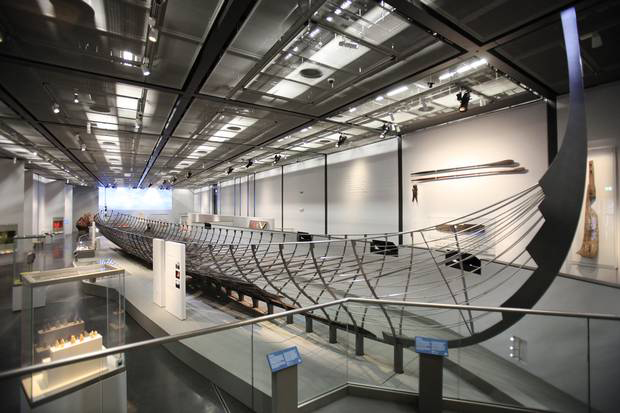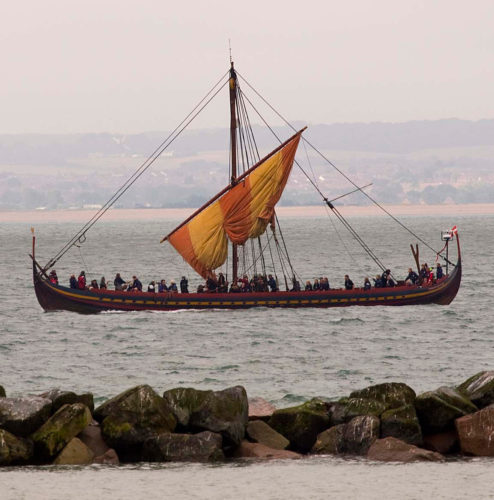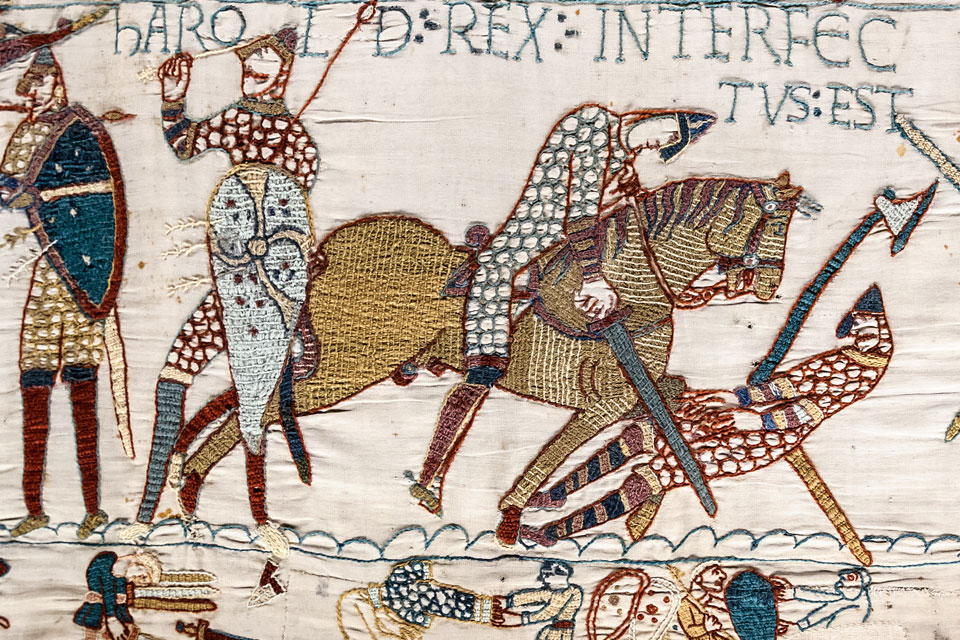How many fought at Hastings? How large was William’s fleet? Why was William’s ship called ‘Mora’? How many perished on the battlefield?
On the 5th of January 1066 Edward the Confessor died and the next day Harold Godwinson was crowned king of England. According to the perceived history, the Duke of Normandy, later known as William the Conqueror, immediately initiated the process, which would end in the Battle of Hastings on the 14th of October leading to his conquest of England.
The questions, though are many. One one hand a number of sources present us with numerous details about the events which led up to the battle and the actual happenings. on the other hand, the sources – the Bayeux Tapestry, Poems, Chronicles, Documents – tell us very different stories.
The Fleet and the Ships
 The Viking Ship – Roskilde 6 – exhibited in London 2013
The Viking Ship – Roskilde 6 – exhibited in London 2013One of the more intriguing questions is how William was able to amass the ships and the men need for carrying out the expedition.
According to William of Jumièges and William of Poitiers the invasion was planned after a deliberation at two councils called by the Duke in the early spring of 1066. Following this the spring and summer was spent preparing the fleet. As William of Jumièges writes there were 694 ships besides unnumbered boats and skiffs “for the purpose of carrying the arms and harnesses. Another source – “I have found it written (but I know not whether it be true) that there were in all three thousand vessels bearing sails and masts. Any one will know that there must have been a great many men to have furnished so many vessels.” According to “The Ship List” – a source from the 13th century, but probably a partly abstract of the original agreement – the lords and Barons in Normandy each agreed to deliver the number of ships as well as knights and soldiers according to their wealth. This source lists 778 specified ships, but adds it up to over a 1000 (perhaps by adding those which William personally stood for delivering to the common enterprise.) It is probable that this number should have been swelled with numerous skiffs and boats, which were simply rented to carry the material of the army across the channel.
Inspired by the visual rendering in the Bayeux Tapestry and other written sources this navy has often been described as a fleet, which William built from scratch. However, this would have been impossible. It is estimated from the reconstruction of the largest Viking-ship ever rebuilt – the Sea Stallion – that such a ship demanded the investment of the work and time One foreman in ten months
- Ten men in three months sourcing and felling trees
- Four persons in two months to procure 500 l. wood tar
- Ten shipbuilders in seven months
- One smith in eight months
 Sea Stallion Lowering the Sails. Source: Wikipedia
Sea Stallion Lowering the Sails. Source: WikipediaTo this should be added people to rivet planks on, plus working as carpenters on shields, masts and oars.
Just to build a ship would thus take minimum one year with a continuous workforce of 10 – 11 people engaged in the work. Of these jobs at least 69% had to be carried out by skilled workers.
Further, 5 persons had to work for a year to spin the yarn, weave the cloth and sew the sail while five persons in six months were needed to collect the material (500 tails of horses plus bark) and make the rope.
All-in-all 25.8 persons plus that entailed in minor work would have to work full time (eight hours a day/six days a week for ten months) in order to build and fit out a ship like the Sea Stallion in the time frame between February and September. To this should be added the countless hours of spinning, weaving and sowing which provided the textiles for dressing the warriors and weaving the rugs for keeping them warm when on the sea as well as the smiths neaded to provide the weapons.
It does not make sense to imagine that so many skilled shipbuilders were around – or for that matter could be spared in the industry of house-building and the general working of the land. This was no new fleet built from scratch, but one amassed, perhaps commandeered and probably partly rented for the occasion by William and his friends. The time from February and until September was sorely needed just to repair and fit out the men and ships, which were already available.
Another reason why the fleet must have consisted of existent ships is the size of the forest, which would have to be “plundered” in order to build the ships from anew. Already in 1986, Gillmor calculated that 41% of the forests along the Seine would have had to be felled in order to procure hardwood for the ships pooled by William’s three largest partners.
Horse transports
One particular type of ships have amassed some interest: the horse transports.
In several articles Bernard Bachrach has dealt with this challenge: to procure ships, which would allow a substantial number of horses (3000) be shipped together with their knights across the channel. For this purpose especially designed ramps were required as were ship-floors divided into stalls. Horses frighten when on-board ships if not tethered properly and held down with halter rigs, body straps and legs wrapped in cloth. It has been suggested that a number of ship-builders were imported from the Mediterranean to construct the special vessels needed for this purpose.
It is correct that such ships have not been archaeologically documented in a North European context; however, it is a fact that horses were brought by the Norse to the Faroe Island and Iceland at least from the 10th century. The Vikings will have been well versed in ways of both loading and transporting such animals long before 1066. Whether or not they used the transport-technologies developed by the Byzantines, as has been suggested, is another matter. However, it is totally unlikely that shipbuilders were “imported” from the Normans via Sicily to build this new type of ship in the ports of Normandy. There are 2107 nautical miles from Caen to Palermo and it takes minimum a month to sail from Caen to Palermo with 8 knots pr. hour and sailing steadily for eight hours a day. Average speed has been measured for the Sea Stallion to be 6-8 knots with 17 knots for top speed by sail. It would thus take at least two months to get a ship back and forth as well as sourcing and finding skilled shipbuilders in the Mediterranean. It is more likely messengers were sent to the Normans in Southern Italy inviting them on board the project and with clear information about when and where to meet up with their ships in Normandy in order to take part in the expedition; (some of these would probably also “owe” their cousins back home for having invested in the Norman expedition to Southern Italy).
Finally, yet another reason for the fleet consisting of “used” ships is that it takes time to learn how to sail such vessels. Although the often-repeated dogma that William and his followers were landlubbers seems nonsensical, new ships had to be “broken in” by their captains. Even if It is likely the Normans in this sense were much more true to their Viking heritage and is often thought, this would have taken some time.
The Mora
However, new ships were definitely built, though there is no reason to believe they were different from the standard Viking ships as we know them from the excavations at Roskilde (carrying both sails and oarlocks).
One new ship, we know some details about is the Mora, which carried the leader of the expedition – Duke William – across the Channel. This ship is well known from two sources. In one text (the ship list mentioned above), we learn that the ship was built by the Duchess Matilda as a gift to her husband; this ship was provided in the stern with a golden figurehead in the form of an infant who pointed with his right forefinger towards England and with his left hand pressed a horn against his lips. Exactly this detail can also be found embroidered in the Bayeux Tapestry. In general, though, the ships were fitted with carved heads of dragons, horses, birds or man-beasts.
The name ‘Mora’ has puzzled people for years. Mora has been understood as stemming from ‘Morini’ the ancient inhabitants of Flanders or alternatively meaning ‘foolish or jester’. A third explanation has been that the name stems from Latin: delay or pause. However, neither of these explanations seems particularly meaningful. A fourth hypothesis is that the name ‘Mora’ was heard/written/remembered wrongly, when it was recorded later on. Perhaps it should be ‘Mara’ meaning a (ferocious or wild) female horse; a word also known from cauchemar – nightmare. It is perhaps significant in this connection that the ship as seen in the Bayeux Tapestry also carried at it prow what might very well be understood as a female horse.
Size of the Army
 Battle of Hastings 1066 – 2016. © David Boyle
Battle of Hastings 1066 – 2016. © David BoyleThus, there is no doubt – given the time frame of the preparation – that the fleet consisted of a large number of very diverse ships, boats and skiffs. However, at the core were probably a number of ships like the Sea Stallion, which carries 60 oars and up to 70 men. But if all the 696 ships had this size – and all had carried just men – the army would have been 42.640 men.
However, this would mean that perhaps every third able-bodied Norman would have been on board a ship heading for England; more likely is the figure of 10-14.000 men indicated by the Chronicle of St. Maixent (c. 1126 – 40). With a population size of c. 660.000 in Normandy (a fifth of present-day with a density of 20/km2) this would mean that every 8th man was enrolled in the army; which is a more reasonable figure albeit in the upper range. It is probably more reasonable to reckon with an army the size of maximum 10.000 men of which perhaps 2-3000 were mounted knights; these are the figures, Bernard S. Bachrach has argued for. This also fits well with the five to seven thousand men who fought at Hastings and were afterwards rewarded by William.
Opposite this contingent of Norman foot soldiers, archers and cavalry stood the Anglo-Saxon army of Harold, which had taken position on a ridge forming a phalanx of soldiers deployed as a shield-wall. Exactly how large is unknown. Likely, though, it consisted of foot-soldiers from Southern England plus the elite troops brought down from Stanford Bridge
The Battle and the Losses
As far as can be ascertained from the sources, the Norman army began by bombarding the Anglo-Saxons with a salvo of arrows and bolts from cross-bows. At some point the Normans feigned a retreat, which lured the Anglo-Saxons down from the ridge. However, even though the cavalry now entered the scene, it was obviously touch and go. At some point, it is told, William had to rally his troops by telling them there were no ships to run back to as the fleet had taken refuge out on the sea. Finally, Harold died by an arrow, which entered his eye as is independently documented by both the Bayeux Tapestry and Amateus of Montecassino. At this point, the remains of Anglo-Saxon army fled. However, the usual hunting down of the fleeing soldiers probably did not take place. For one, the horses of the Anglo-Saxons had been kept at the rear, while those of the Normans had been spent in battle. Also, night was falling and made it easier to slip away. Thus ended one of the most important pitched battles fought in the Middle Ages.
It is known that William ended up rewarding land to the five to seven thousand of his men, who had taken part in the Battle at Hastings. If his army mustered 10.000 and 3000 died, it is probable that the same number of Anglo-Saxons perished in the battlefield. However, the main reason why the Anglo-Saxons lost was probably not the military defeat as such, but rather the final loss of crucial leadership, when Harold and his brothers, Gyrth and Leowine died.
SOURCES:
Identity and Status in the Bayeux tapestry: the Iconographic and Ar...
By Michael John Lewis
In: Anglo-Norman Studies (200) Vol. 29, pp. 100 – 120
Naval Logistics of the Cross-Channel Operation, 1066
By C.M. Gillmor
In: Anglo-Norman Studies (1984) Vol 7, pp. 105 – 31
[NB: this article was written before the later find of the largest Viking ship discovered at Roskilde]
Some Observations on the military administration of the Norman Conq...
By Bernard S. Bachrach
In: Anglo-Norman Studies (1985) Vol 8, pp 1 – 26
The Norman Conquest, Countess Adela and Abbot Baudri
By Bernard S. Bachrach
In: Anglo-Norman Studies XXXV: Proceedings of the Battle Conference 2012, pp. 65 – 80
Review: The Norman Conquest: The Battle of Hastings and the Fall of...
by Bernard S. Bachrach, The University of Minnesota
In: Michigan War Studies Review 2014
The Ship List of William the Conqueror
By Elisabeth M. C. van Houts
In: Anglo-Norman Studies (1987), vol. 10, pp. 159-183
GENERAL INTRODUCTION:
1066 – Battle of Hastings: History and Sources
READ MORE:
The Battle of Hastings: Sources and Interpretations
Ed. By Stephen Morillo
Boydell and Brewer
The Norman Conquest: The Battle of Hastings and the Fall of Anglo-S...
By Marc Morris
Pegasus Books 2014
 http://www.medievalhistories.com/wp-content/uploads/WEB-Bayeux_Tapestry_scene-57_Harold_death-wikipedia-1-500x333.jpg 500w,
http://www.medievalhistories.com/wp-content/uploads/WEB-Bayeux_Tapestry_scene-57_Harold_death-wikipedia-1-500x333.jpg 500w, 

















Pentru a putea adăuga comentarii trebuie să fii membru al altmarius !
Alătură-te reţelei altmarius